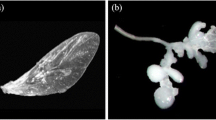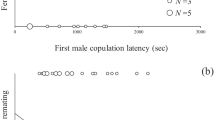Abstract
Whether females gain indirect genetic benefits through mate choice is a controversial issue since this requires additive genetic variance in the preferred male traits. Condition dependence could maintain the necessary genetic variance by linking the expression of male traits to the supposedly large number of genes affecting condition. Copulating males of the red flour beetle Tribolium castaneum rub their legs along the female elytra. Females favor males with vigorous rubbing through cryptic female choice. We measured the repeatability and heritability of this behavior and assessed its potential use as indicator of viability and condition. We found genetic variance in larval to adult survival and in the rate of leg rubbing in males. However, the rate of leg rubbing was not related to offspring survival or condition dependent. The genetic variance in leg rubbing was mostly non-additive with very low narrow sense heritability. Therefore, we failed to document any indirect genetic benefits to choosy females through viability of their offspring or attractiveness of their sons.

Similar content being viewed by others
References
Andersson M. (1994). Sexual Selection. Princeton University Press, Princeton, New Jersey
Arnqvist G., Thornhill R. (1998). Evolution of animal genitalia: patterns of phenotypic and genotypic variation and condition dependence of genital and non-genital morphology in water strider (Heteroptera: Gerridae: Insecta). Genet. Res. 71:193–212
Bakker T. C. M. (1999). The study of intersexual selection using quantitative genetics. Behaviour 136:1237–1266
Bernasconi G., Keller L. (2001). Female polyandry affects their sons’ reproductive success in the red flour beetle Tribolium castaneum. J. Evol. Biol. 14:186–193
Bjorksten T., David P., Pomiankowski A., Fowler K. (2000). Fluctuating asymmetry of sexual and nonsexual traits in stalk-eyed flies: a poor indicator of developmental stress and genetic quality. J. Evol. Biol. 13:89–97
Bloch Qazi M. C. (2003). A potential mechanism for cryptic female choice in a flour beetle. J. Evol. Biol. 16:170–176
Borgia G. (1979). Sexual selection and the evolution of mating systems. In: Blum M. S., Blum N. A. (eds). Sexual Selection and Reproductive Competition in Insects. Academic, New York, pp. 19–80
Córdoba-Aguilar A. (1999). Male copulatory sensory stimulation induces female ejection of rival sperm in a damselfly. Proc. R. Soc. Lond. B 266:779–784
Eberhard W. G. (1996). Female control: Sexual selection by cryptic female choice. Princeton University Press, Princeton New Jersey
Edvardsson M., Arnqvist G. (2000). Copulatory courtship and cryptic female choice in red flour beetles Tribolium castaneum. Proc. R. Soc. Lond. B 267:559–563
Falconer D. S. (1973). Replicated selection for body weight in mice. Genet. Res. 22:291–321
Falconer D. S., Mackay T. F. C. (1996). Introduction to Quantitative Genetics. 4th edn Longman, Harlow
Grafen A. (1990). Sexual selection unhandicapped by the Fisher process. J. Theor. Biol. 144:473–516
Houle D., Kondrashov A. S. (2002). Coevolution of costly mate choice and condition-dependent display of good genes. Proc. R. Soc. Lond. B 269:97–104
Kirkpatrick M., Ryan M.J. (1991). The evolution of mating preferences and the paradox of the lek. Nature 350:33–38
Kotiaho J. S., Simmons L. W., Tomkins J. L. (2001). Towards a resolution of the lek paradox. Nature 410:684–686
Lessells C. M., Boag P. T. (1987). Unrepeatable repeatabilities: A common mistake. Auk 104:116–121
Lorch P. D., Proulx S., Rowe L., Day T. (2003). Condition-dependent sexual selection can accelerate adaptation. Evol. Ecol. Res. 5:867–881
Møller A. P., Alatalo R. V. (1999). Good-genes effects in sexual selection. Proc. R. Soc. Lond. B 266:85–91
Ottoni E.B. (2000). EthoLog 2.2: a tool for the transcription and timing of behavior observation sessions. Behav. Res. Meth. Ins. C. 32:446–449
Pai A., Yan G.Y. (2002). Polyandry produces sexy sons at the cost of daughters in red flour beetles. Proc. R. Soc. Lond. B 269:361–368
Pai A., Yan G. (2003). Effects of tapeworm infection on male reproductive success and mating vigor in the red flour beetle, Tribolium castaneum. J. Parasitol. 89:516–521
Rowe L., Houle D. (1996). The lek paradox and the capture of genetic variance by condition dependent traits. Proc. R. Soc. Lond. B 263:1415–1421
Ryan M.J. (1998). Sexual selection, receiver biases, and the evolution of sex differences. Science 281:1999–2003
Sakaluk S. K. (2000). Sensory exploitation as an evolutionary origin to nuptial food gifts in insects. Proc. R. Soc. Lond. B 267:339–343
Shaw F. H., Shaw R. G., Wilkinson G. S., Turelli M. (1995). Changes in genetic variances and covariances: G whiz!. Evolution 49:1260–1267
Shaw R. G. (1987). Maximum-likelihood approaches applied to quantitative genetics of natural populations. Evolution 41:812–826
Shuster M., Wade M.J. (2003). Mating Systems and Strategies. Princeton Univeristy Press, Princeton New Jersey
Sokoloff, A. (1972). The Biology of Tribolium with Special Emphasis on Genetic Aspects. vol. 1. Oxford University Press, Oxford
Sokoloff A. (1974). The Biology of Tribolium with Special Emphasis on Genetic Aspects. vol. 2. Oxford University Press, Oxford
Sokoloff A., Slatis H. M., Stanley J. (1960). The black mutation in Tribolium castaneum. J. Hered. 51:131–135
Tallamy D. W., Powell B. E., McClafferty J.A. (2002). Male traits under cryptic female choice in the spotted cucumber beetle (Coleoptera: Chrysomelidae). Behav. Ecol. 13:511–518
Tallamy D. W., Burton Darlington M., Pesek J. D., Powell B. E. (2003). Copulatory courtship signals male genetic quality in cucumber beetles. Proc. R. Soc. Lond. B 270:77–82
Thornhill R. (1983). Cryptic female choice and its implications in the scorpionfly Harpobittacus nigriceps. Am. Nat. 122:765–788
Tomkins J. L., Radwan J., Kotiaho J. S., Tregenza T. (2004). Genic capture and resolving the lek paradox. Trends Ecol. Evol. 19:323–328
Acknowledgments
We thank three anonymous reviewers for valuable comments and the Swedish Research Council for financial support.
Author information
Authors and Affiliations
Corresponding author
Rights and permissions
About this article
Cite this article
Edvardsson, M., Arnqvist, G. No Apparent Indirect Genetic Benefits to Female Red Flour Beetles Preferring Males with Intense Copulatory Courtship. Behav Genet 36, 775–782 (2006). https://doi.org/10.1007/s10519-005-9043-6
Received:
Accepted:
Published:
Issue Date:
DOI: https://doi.org/10.1007/s10519-005-9043-6




